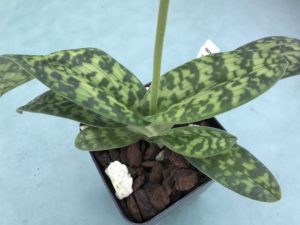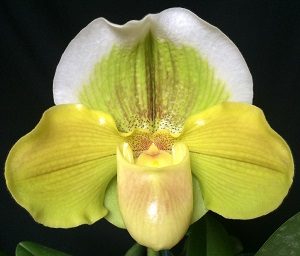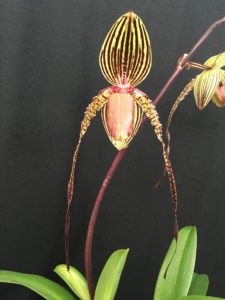Paphiopedilum Care and Feeding
Introduction
So you’ve bought yourself a Paph… good choice! Now how do you keep it happy and healthy? Here is what you need to know about the care and feeding of Paphiopedilum orchids, what you need to know to grow your Paphs like a professional.
Mottled leaf Paphiopedilums
Often referred to as ‘Maudiae’ hybrids, these are among the easiest orchids to grow in the home. They require less light than most other orchids. A north or east window will provide ideal light for these plants. They are considered warm growing, which means they appreciate the same temperatures we do. Days in the 70’s to low 80’s are fine, and night temperatures above 60 F.
Use a balanced fertilizer, like 20-20-20. Orchid roots are sensitive to salts so we recommend fertilizing at about 1/4 to 1/2 the label rate. Use the 1/4 rate if you want to fertilize every time, and the 1/2 rate if you fertilize every other watering.
fertilizer, like 20-20-20. Orchid roots are sensitive to salts so we recommend fertilizing at about 1/4 to 1/2 the label rate. Use the 1/4 rate if you want to fertilize every time, and the 1/2 rate if you fertilize every other watering.
The most important part of watering is to make sure you flush the pot thoroughly. This means watering the plant for a good 10 seconds. This washes out excess salt build up and brings oxygen to the roots.
Speaking of roots, the best way to maintain a healthy root system is to repot these plants every year. They can be repotted any time, even in bud or bloom. Repotting seems to stimulate new root growth and perk up listless plants. There is no ideal mix that suits all growers. We use 1/3 pine bark, 1/3 number 3 perlite and 1/3 charcoal. If you have good quality water you won’t need the charcoal. If you are in a humid climate you may need more perlite or coarse bark to help the plant dry out a bit more between waterings.
Never let these get completely dry, but don’t let the mix get soggy. Water just before they get dry, feed them regularly and repot every year and you will have great success!
Complex Paphiopedilums
These are the ‘bulldog’ Paphs. Known for their huge, colorful, long-lasting flowers.
This is another group that doesn’t require as much light as many other orchids. A north or east window will provide enough light for them to grow and flower. A west or south window can work but the plants need to be protected from the hot sun with sheer curtains. 
As with mottled leaf Paphs, we recommend a balanced fertilizer, like 20-20-20. Orchid roots are sensitive to salts so we recommend fertilizing at about 1/4 to 1/2 the label rate. Use the 1/4 rate if you want to fertilize every watering, and the 1/2 rate if you fertilize every other time.
The most important part of watering is to make sure you flush the pot thoroughly. This means watering the plant for a good 10 seconds. This washes out excess salt build up and brings oxygen to the roots.
Complex Paphs appreciate the same temperatures we do. Days in the 70’s to low 80’s in the summer and nights into the 60’s are fine. Keeping them a few degrees cooler when they are blooming will extend the life of their flowers. They easily tolerate temperatures into the 50’s during winter nights.
Repot these plants every year for best root growth. Old media can break down and become ‘sour’. Repotting stimulates new root tip growth and allow you to remove old, soft roots that no longer function. Small plants to medium plants will do best in fine bark, larger specimen plants may need medium bark as these plants can get quite large if well grown.
As with other Paphs, always flush the pot thoroughly when you water, delivering oxygen to the roots and rinsing out excess salts.
Multifloral Paphiopedilums
These are the largest members of the Paph family. They require a bit more space but the spectacular display of flowers they provide makes them worth it!
 Multiflorals require more light than most other Paphs. They can grow along side of Cattleyas. They also like warm temperatures, 80’s during the day in the summer and nights in the 60’s. They will tolerate 50’s on winter nights but keep them on the dry side when it’s cold to prevent rot.
Multiflorals require more light than most other Paphs. They can grow along side of Cattleyas. They also like warm temperatures, 80’s during the day in the summer and nights in the 60’s. They will tolerate 50’s on winter nights but keep them on the dry side when it’s cold to prevent rot.
A balanced fertilizer will work for this group. They are heavy feeders during the growing season so 1/2 strength of a 20-20-20 plant food will work. Multiflorals require more calcium than some others. This is usually supplied by the calcium occurring in municipal tap water. If you have very soft water or use pure water you may want to add a calcium supplement to your regime. Let these plants dry out a bit between waterings.
Since these plants are rather large, they require a larger grade of bark. Larger bark and drier culture mean that the media will not break down too quickly, so repotting is usually done every other year.
If you live in Florida or a similar climate you can grow these outside under light shade. Just protect them when the rare frosty night comes along.
Do you know someone passionate about Paphs?
Consider giving them a gift card.
